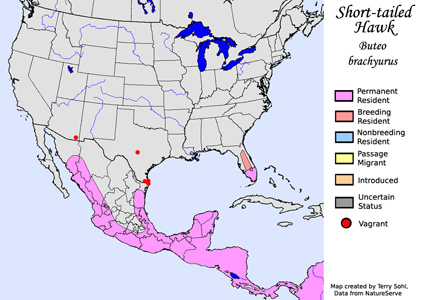| Length: 16 inches | Wingspan: 36 inches | Seasonality: Non-resident in South Dakota |
| ID Keys: Two color morphs, a dark and a light. Light is dark above, white below. Dark morph has completely dark plumage. | ||
 The
Short-tailed Hawk is a tropical hawk that only reaches the U.S. in the
southern half of Florida. Vagrants have also been spotted in extreme
southern Texas and Arizona. Their range extends southward in to much
of Mexico, Central America, and much of South America. Short-tailed
Hawks have very different dietary preferences than other Buteo hawks, with a
strong preference for feeding on small birds.
The
Short-tailed Hawk is a tropical hawk that only reaches the U.S. in the
southern half of Florida. Vagrants have also been spotted in extreme
southern Texas and Arizona. Their range extends southward in to much
of Mexico, Central America, and much of South America. Short-tailed
Hawks have very different dietary preferences than other Buteo hawks, with a
strong preference for feeding on small birds.
Habitat: Typically found in edge habitat where large open expanses of grassland, wetland, or farmland meet forests.
Diet: Mostly feeds on small birds, but they will also occasionally feed on rodents, small snakes, lizards, frogs, and large insects.
Behavior: Typically hunts by slowly gliding or circling, diving after prey when spotted. They will often search for prey from a relatively high flight of a few hundred feet.
Nesting: The nest of a Short-tailed Hawk is a large platform of sticks, with moss, small twigs, or leafy branches used to line the nest. Both sexes help to construct the nest, although the male primarily just brings nest material while the female actually builds the nest. The female alone incubates the eggs, but both sexes will help to raise the young.
Song: Long clear scream, as well as shorter high-pitched calls and screams.
Migration: Many Short-tailed Hawks are permanent residents. However, those in the northern part of their Florida range typically move to the southern part of the Florida peninsula for the winter. Some Mexican populations may also be migratory.
Interactive eBird Map: Click here to access an interactive eBird map of Short-tailed Hawk sightings
Similar Species: Broad-winged Hawk, Swainson's Hawk, White-tailed Hawk
Conservation Status: There are currently no perceived major threats to Short-tailed Hawk populations, and the IUCN cites it as a species of "Least Concern".
Further Information: 1) WhatBird - Short-tailed Hawk
2) University of Michigan's Animal Diversity Web - Short-tailed Hawk
3) Audubon Guide - Short-tailed Hawk
Photo Information: Photo by Terry Sohl - Everglades National Park, Florida
| Click below for a higher-resolution map |
 |
| South Dakota Status: Non-resident in South Dakota |
Additional Short-tailed Hawk Photos

